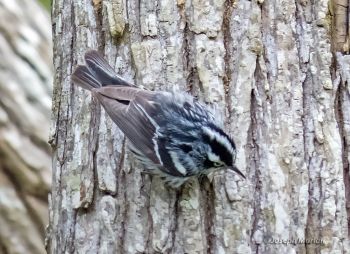JohnN-1520 (talk | contribs) |
|||
| (20 intermediate revisions by 8 users not shown) | |||
| Line 1: | Line 1: | ||
| − | + | [[File:Black-and-white_Warbler_LRNZ.jpg|thumb|550px|right|Photo © by {{user|Lorenz_C|Lorenz_C}}<br />Gilbert, Arizona, USA, 29 January 2021]] | |
| − | [[ | + | ;[[:Category:Mniotilta|Mniotilta]] varia |
==Identification== | ==Identification== | ||
| − | + | [[Image:Black and White Warbler 74 4309.jpg|thumb|350px|right|Female<br />Photo © by {{user|STEFFRO1|STEFFRO1}}<br />Brookgreen Gardens, Murrells Inlet, [[South Carolina]], October 2018]] | |
| + | 11–13 cm (4¼-5 in)<br /> | ||
| + | Quite distinct; the only black and white striped warbler. | ||
| + | ==Distribution== | ||
| + | [[File:Black-and-white_Warbler_SY_JMOR.jpg|thumb|350px|right|SY – second calendar year<br />Photo © by {{user|jmorlan|Joseph Morlan}}<br />[[High Island]]-Smith Oaks Sanctuary<br /> [[Bolivar Peninsula]], [[Texas]], [[USA]],19 April 2021]] | ||
| + | Breeds across most of the eastern [[United States]]; also in northern and central western [[Canada]]. In migration found throughout eastern [[United States]]. | ||
| + | |||
| + | Winters south from [[Mexico]] to [[Peru]]. | ||
| + | ==Taxonomy== | ||
| + | [[Image:Black and White Warbler 74 6734.jpg|thumb|350px|right|Photo © by {{user|STEFFRO1|Robert Steffens}}<br />Collins Creek Landing, Murrells Inlet, [[South Carolina]], 26 January 2019]] | ||
| + | This is a [[Dictionary_M-O#M|monotypic]] species<sup>[[#References|[1]]]</sup>. | ||
| + | |||
| + | ==Habitat== | ||
| + | Deciduous and mixed forests, particularly in ravines and on hillsides. In migration can be found in most wooded areas. | ||
| + | ==Behaviour== | ||
| + | Acts very much like a Nuthatch, foraging up and down trees. | ||
| + | ====Diet==== | ||
| + | Their main diet consists of insects and arthropods. They also occasionally eat fruit in the winter months. | ||
| + | ====Breeding==== | ||
| + | They construct a cup-shaped nest from grass, leaves, strips of bark and moss. | ||
| + | ==References== | ||
| + | #{{Ref-Clements6thAug19}}#Curson, J. (2020). Black-and-white Warbler (Mniotilta varia). In: del Hoyo, J., Elliott, A., Sargatal, J., Christie, D.A. & de Juana, E. (eds.). Handbook of the Birds of the World Alive. Lynx Edicions, Barcelona. (retrieved from https://www.hbw.com/node/61496 on 31 January 2020). | ||
| + | {{ref}} | ||
| + | |||
| + | |||
| + | |||
| + | |||
| + | |||
| + | |||
| + | |||
| + | |||
==External Links== | ==External Links== | ||
| − | {{GSearch| | + | {{GSearch|"Mniotilta varia" {{!}} "Black-and-white Warbler"}} |
| − | [[Category:Birds]] | + | {{GS-checked}}1 |
| + | <br /> | ||
| + | <br /> | ||
| + | |||
| + | [[Category:Birds]] [[Category:Mniotilta]] | ||
Latest revision as of 22:54, 16 November 2023
- Mniotilta varia
Identification
11–13 cm (4¼-5 in)
Quite distinct; the only black and white striped warbler.
Distribution

Photo © by Joseph Morlan
High Island-Smith Oaks Sanctuary
Bolivar Peninsula, Texas, USA,19 April 2021
Breeds across most of the eastern United States; also in northern and central western Canada. In migration found throughout eastern United States.
Winters south from Mexico to Peru.
Taxonomy
This is a monotypic species[1].
Habitat
Deciduous and mixed forests, particularly in ravines and on hillsides. In migration can be found in most wooded areas.
Behaviour
Acts very much like a Nuthatch, foraging up and down trees.
Diet
Their main diet consists of insects and arthropods. They also occasionally eat fruit in the winter months.
Breeding
They construct a cup-shaped nest from grass, leaves, strips of bark and moss.
References
- Clements, J. F., T. S. Schulenberg, M. J. Iliff, S. M. Billerman, T. A. Fredericks, B. L. Sullivan, and C. L. Wood. 2019. The eBird/Clements Checklist of Birds of the World: v2019. Downloaded from http://www.birds.cornell.edu/clementschecklist/download/
- Curson, J. (2020). Black-and-white Warbler (Mniotilta varia). In: del Hoyo, J., Elliott, A., Sargatal, J., Christie, D.A. & de Juana, E. (eds.). Handbook of the Birds of the World Alive. Lynx Edicions, Barcelona. (retrieved from https://www.hbw.com/node/61496 on 31 January 2020).
Recommended Citation
- BirdForum Opus contributors. (2024) Black-and-white Warbler. In: BirdForum, the forum for wild birds and birding. Retrieved 25 June 2024 from https://www.birdforum.net/opus/Black-and-white_Warbler
External Links
GSearch checked for 2020 platform.1






